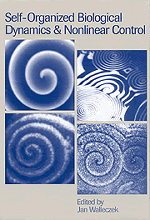 Self-Organized Biological Dynamics and Nonlinear Control
Self-Organized Biological Dynamics and Nonlinear Control Book contents
- Frontmatter
- Contents
- List of contributors
- Preface
- The frontiers and challenges of biodynamics research
- Part I Nonlinear dynamics in biology and response to stimuli
- Part II Nonlinear sensitivity of biological systems to electromagnetic stimuli
- 6 Electrical signal detection and noise in systems with long-range coherence
- 7 Oscillatory signals in migrating neutrophils: effects of time-varying chemical and electric fields
- 8 Enzyme kinetics and nonlinear biochemical amplification in response to static and oscillating magnetic fields
- 9 Magnetic field sensitivity in the hippocampus
- Part III Stochastic noise-induced dynamics and transport in biological systems
- Part IV Nonlinear control of biological and other excitable systems
- Index
9 - Magnetic field sensitivity in the hippocampus
Published online by Cambridge University Press: 14 August 2009
- Frontmatter
- Contents
- List of contributors
- Preface
- The frontiers and challenges of biodynamics research
- Part I Nonlinear dynamics in biology and response to stimuli
- Part II Nonlinear sensitivity of biological systems to electromagnetic stimuli
- 6 Electrical signal detection and noise in systems with long-range coherence
- 7 Oscillatory signals in migrating neutrophils: effects of time-varying chemical and electric fields
- 8 Enzyme kinetics and nonlinear biochemical amplification in response to static and oscillating magnetic fields
- 9 Magnetic field sensitivity in the hippocampus
- Part III Stochastic noise-induced dynamics and transport in biological systems
- Part IV Nonlinear control of biological and other excitable systems
- Index
Summary
Introduction
We think of the brain as our very own computer, a never-ending process of signaling, providing overall guidance for the body and ultimately defining who we are. A multitude of signaling means has evolved for this task, combining mechanical, chemical and electrical communication into a complex network. As we consider the diversity among the types of signal present in the brain, it is not surprising that dynamical processes are also utilized to deliver its messages. Signals of electrical origin are particularly suitable for modulation in time. We see direct evidence of this by examining an electroencephalogram (EEG) or its magnetic counterpart, the magnetoencephalogram (MEG). These techniques provide ways of visualizing the natural rhythms occurring during various brain activities.
The hippocampus is an important structure in the brain that is particularly interesting within the context of dynamical signaling. It is central to the seemingly disparate phenomena of memory function and epilepsy. These two expressions of hippocampal activity are associated with normal and pathological behavior, both of which turn out to be responsive to manipulation with drugs as well as magnetic fields. In vitro studies of the rat hippocampus led us to conclude that an externally applied magnetic field with a steady low-frequency oscillation is capable of mimicking the function of nitric oxide (NO) in this model system. Rhythmic slow activity (RSA, or theta rhythm), which is correlated with learning and attention, is modified when the NO pathway is manipulated, either with drugs or with a low-frequency magnetic flux density of about 50 to 500 microtesla (μT).
Information
- Type
- Chapter
- Information
- Self-Organized Biological Dynamics and Nonlinear ControlToward Understanding Complexity, Chaos and Emergent Function in Living Systems, pp. 216 - 234Publisher: Cambridge University PressPrint publication year: 2000